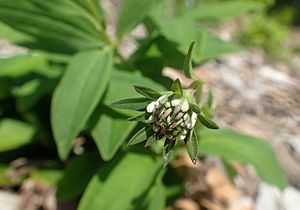Marshallia facts for kids
Quick facts for kids Barbara's buttons |
|
|---|---|
 |
|
| Marshallia trinervia | |
| Scientific classification | |
| Kingdom: | |
| (unranked): | |
| (unranked): | |
| (unranked): | |
| Order: | |
| Family: | |
| Subfamily: |
Asteroideae
|
| Tribe: | |
| Genus: |
Marshallia
Schreb. 1791 not J.F.Gmel. 1791 (Salicaceae)
|
| Synonyms | |
|
|
Marshallia is a group of pretty flowering plants. They are part of the sunflower tribe within the daisy family. These plants are mostly found in the southeastern and south-central United States. Many people call them Barbara's buttons because their flowers look a bit like buttons.
Contents
What are Barbara's Buttons?
These plants like to grow in open areas. You can find them along roadsides, in wet areas called bogs, or in open woodlands where pine trees grow. Some types of Barbara's buttons especially like wetlands.
When Do They Bloom?
Barbara's buttons usually bloom in late spring, around May, and early summer, in June or early July. Their small flowers can be white or pinkish. They grow together in large, round, compact heads.
Pollinators and the Flowers
These flowers are very attractive to insects that help with pollination. This includes many kinds of butterflies and different beetles. For example, flower chafers from the Euphoria group love to visit them.
Different Types of Barbara's Buttons
There are several different species, or types, of Marshallia plants. Each one has its own special name and grows in certain parts of the United States:
- Marshallia angustifolia - found in TN
- Marshallia caespitosa (Puffballs) - found in TX, OK, KS, MO, AR, LA
- Marshallia graminifolia (Grassleaf Barbara's buttons) - found in TX, LA, MS, AL, GA, FL, SC, NC
- †Marshallia grandiflora (Appalachian Barbara's buttons) - found in NC
- Marshallia legrandii (Tall Barbara's buttons) - found in NC, VA
- Marshallia mohrii (Mohr's Barbara's buttons) - found in AL, GA
- Marshallia obovata (Spoonshape Barbara's buttons) - found in TN, AL, GA, FL, SC, NC, VA
- Marshallia pulchra (Beautiful Barbara’s buttons) - found in TN, KY, WV, MD, PA
- Marshallia ramosa (Southern Barbara's buttons) - found in FL, GA
- Marshallia trinervia (Broadleaf Barbara's buttons) - found in LA, MS, AL, GA, SC, NC, TN
Conservation Status
Sadly, one type of Barbara's buttons, Marshallia grandiflora (Appalachian Barbara's buttons), is now extinct. This means it has completely disappeared from Earth. It was wiped out in the early 1900s.
Another species, Marshallia pulchra (Beautiful Barbara's buttons), is endangered in some states like Kentucky, Pennsylvania, and Tennessee. It has even disappeared from Maryland. This plant grows in bogs and along riverbanks. It needs regular flooding to keep its habitat open and healthy.
Marshallia obovata (Spoonshape Barbara's buttons) is also endangered in Florida and threatened in Tennessee. Protecting these special plants helps keep our natural world diverse and healthy.
Where Did the Name Come From?
The scientific name for the genus, Marshallia, was given by a botanist named Schreber in 1791. He named it to honor the Marshall family from Pennsylvania. Humphry Marshall and his nephew Moses were botanists during America's colonial period. They were also cousins to the famous botanists and explorers John and William Bartram.
The Mystery of "Barbara's Buttons"
The reason for the common name "Barbara's buttons" is not fully known. The flower heads do look a bit like buttons. However, old plant books that use this name do not say which "Barbara" it refers to.
Some people think it might be named after Saint Barbara. She is a saint often shown with long hair and is also linked to lightning. Perhaps the individual flowers look like tiny lightning bolts. Or maybe the whole flower head looks like Saint Barbara's long hair.
This common name was not widely used in the 1800s. It wasn't in books like Southern Wildflowers and Trees (1901). A botanist named B.W. Wells called the plants "loudspeakers" in 1932 because of the megaphone shape of the individual flowers. The first time "Barbara's buttons" was printed in a book was in 1933, in Small's Manual of the Southeastern Flora.
See also
 In Spanish: Marshallia para niños
In Spanish: Marshallia para niños

